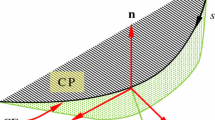Abstract
Mixed mode fracture in a certain high strength steel has been investigated through physical experiments and numerical calculations. The main objective has been to investigate the implications of local crack tip processes on the macroscopic mixed mode fracture behaviour. A scrutiny of the fractured specimens revealed evidence of crack branching in all cases where β_eq < 40° ( β_eq = atan ( K_I /K_II ) ). The appearance of branching was found to be accompanied to a rather abrupt increase in the macroscopic mixed mode fracture toughness. In the numerical calculations the effective plastic strain criterion suggested by Hallbäck and Nilsson (1994) was applied to the present material. Crack tip branching was from the analysis predicted to occur at β_eq = 60°. Besides the presence of branching, it was however questionable whether the analysis corroborated the experimentally observed behaviour.
Similar content being viewed by others
References
ABAQUS (1993). User's manual — version 5.3, Hibbit, Karlsson and Sorensen Inc., Providence, RI.
Aoki, S., Kishimoto, K., Yoshida, T., Sakata, M. and Richard, H.A. (1990). Elastic-plastic fracture behaviour of an aluminium alloy under mixed mode loading. Journal of the Mechanics and Physics of Solids 38, 195–213.
Arcan, M., Hashin, Z. and Volodshin, A. (1978). A method to produce uniform plane-stress states with applications to fiber-reinforced materials. Experimental Mechanics 18, 141–146.
ASTM E-399 (1990). Standard Test Method for Plane-stain Fracture Toughness of Metallic Materials, Annual Book of ASTM Standards, Sect. 3, American Society for Testing and Materials, PA.
Bhattacharjee, D. and Knott, J.F. (1994). Ductile fracture in HY100 steel under mixed mode I/mode II loading. Act Metallurgica et Materialia 42, 1747–1754.
Cardew, C.E., Goldthorpe, M.R., Howard, I.C. and Kfouri, P. (1985). On the elastic T-term. Fundamentals of Deformation and Fracture, Proceedings of the Eshelby Memorial Symposium (Edited by B.A. Bilby, K.J. Miller and J.R. Willis), Sheffield 2–5 April 1984, Cambridge University Press, 465–476.
Erdogan, F. and Sih, G.C. (1963). On the crack extension in plates under plane loading and transverse shear. Journal of Basic Engineering 85, 519–525.
Hallbäck, N. (1996). The influence of finite geometry and material properties on mixed-mode fracture of aluminium. Report 193, Department of solid mechanics, Royal institute of technology, Stockholm, Sweden, to appear in International Journal of Fracture.
Hallbäck, N. and Jönsson, N. (1996). T-stress evaluations of mixed-mode fracture specimens and T-effects on mixed-mode failure of aluminium. International Journal of Fracture 76, 141–168.
Hallbäck, N. and Nilsson, F. (1994). Mixed-mode I/II fracture behaviour of an aluminium alloy. Journal of the Mechanics and Physics of Solids 42, 1345–1374.
Hutchinson, J.W. (1968). Singular behaviour at the end of a tensile crack in a hardening material. Journal of the Mechanics and Physics of Solids 16, 13–31.
Knott, J.F. (1980). Micro mechanisms of fibrous crack extension in engineering alloys. Metal Science 14, 327–336.
Maccagno, T.M. and Knott, J.F. (1991). The low temperature brittle fracture behaviour of steel in mixed modes I and II. Engineering Fracture Mechanics 38, 111–128.
Maccagno, T.M. and Knott, J.F. (1992). The mixed mode I/II fracture behaviour of lightly tempered HY130 steel at room temperature. Engineering Fracture Mechanics 41, 805–820.
Ohno, N. and Hutchinson, J.W. (1984). Plastic flow localization due to non-uniform void distribution. Journal of the Mechanics and Physics of Solids 32, 63–85.
Rice, J.R. (1976). The localization of plastic deformation. Theoretical and Applied Mechanics 14th IUTAM Congress (Edited by W.T. Koiter), North-Holland, Amsterdam, 207–220.
Rice, J.R. and Johnsson, M.A. (1970). The role of large crack tip geometry changes in plane strain fracture. Inelastic Behaviour of Solids (Edited by M.F. Kanninen, W.F. Adler, A.R. Rosenfield and R.I. Jaffee), McGraw-Hill Series in Material Science and Engineering, New York, 641–672.
Rice, J.R. and Rosengren, G.F. (1968). Plane strain deformation near a crack tip in a power law hardening material. Journal of the Mechanics and Physics of Solids 16, 1–12.
Richard, H.A. and Benitz, K. (1982). A loading device for the creation of mixed mode in fracture mechanics. International Journal of Fracture 22, R55–R58.
Saje, M., Pan, J. and Needleman, A. (1982). Void nucleation effects on shear localization in porous plastic solids. International Journal of Fracture 19, 163–182.
Shih, C.F. (1974). Small-scale yielding analysis of mixed-mode plane-strain crack problems. In Fracture Analysis, ASTM STP 560, American Society for Testing and Materials, Philadelphia, PA, 187–210.
Tohgo, K., Otsuka, A. and Gao, H.W. (1988). Behaviour of ductile crack initiation from a notch under mixed mode loading. Proceedings of the Far East Fracture Group Workshop (Edited by M. Sakata), Tokyo Institute of Technology, Japan, 101–108.
Williams, M.L. (1957). On the stress distribution at the base of a stationary crack. Journal of Applied Mechanics 24, 111–114.
Williams, J.G. and Ewing, P.D. (1972). Fracture under complex stress — The angled crack problem. International Journal of Fracture 8, 441–446.
Yamamoto, H. (1978). Conditions for shear localization in the ductile fracture of void-containing materials. International Journal of Fracture 14, 347–365.
Yokobori, T., Yokobori Jr., A. T., Sato, K. and Omotani, M. (1993). The effect of ferrite grain size on fracture of low carbon steel under mixed modes I and II, Engineering Fracture Mechanics 17, 75–85.
Author information
Authors and Affiliations
Rights and permissions
About this article
Cite this article
Hallbäck, N. Mixed-mode I/II fracture behaviour of a high strength steel. International Journal of Fracture 87, 363–388 (1997). https://doi.org/10.1023/A:1007448511822
Issue Date:
DOI: https://doi.org/10.1023/A:1007448511822




